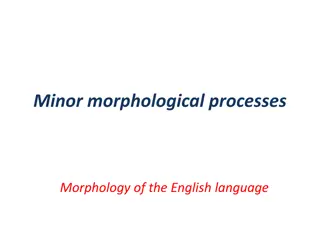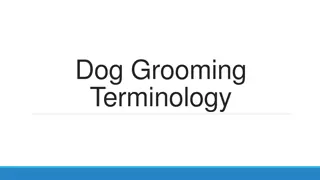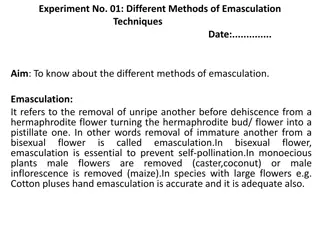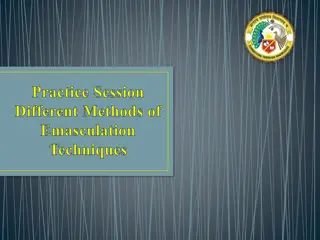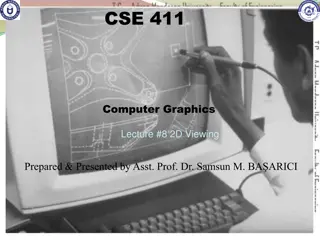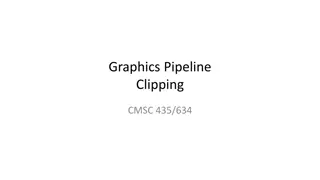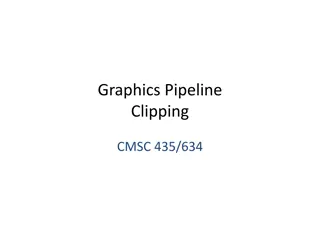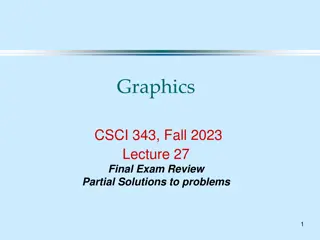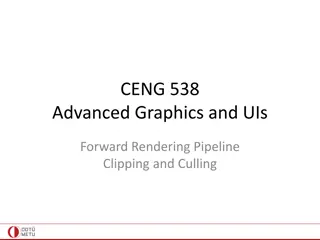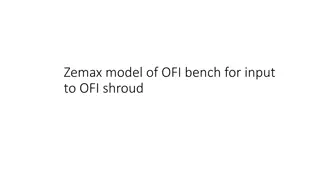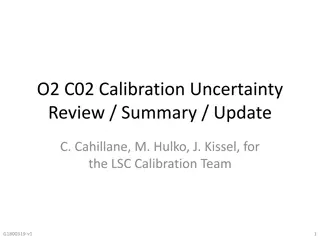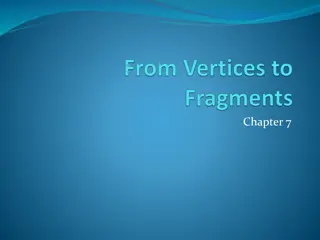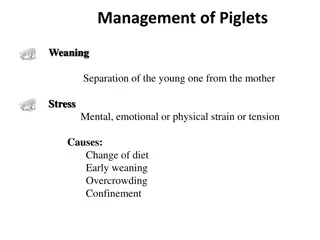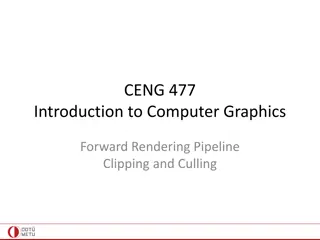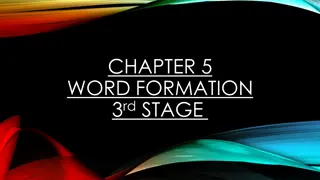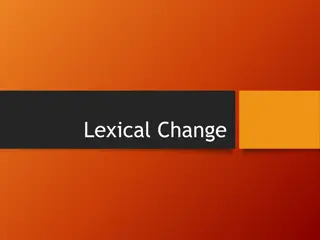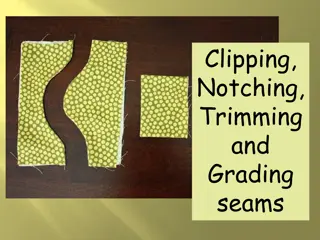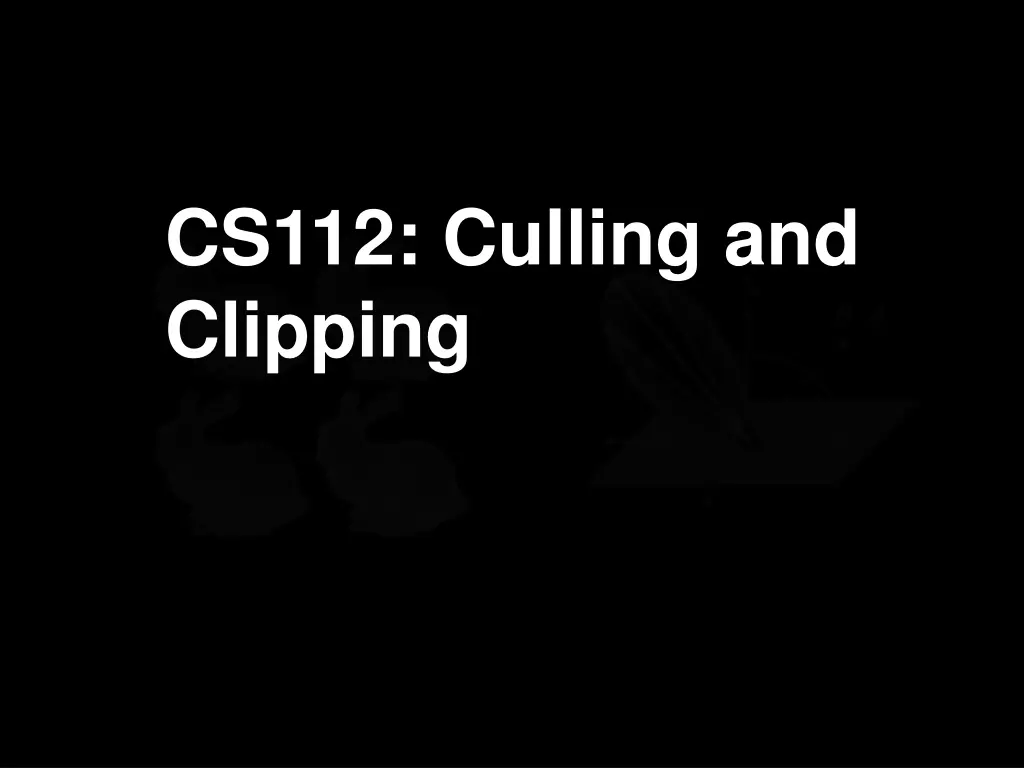
Understanding Culling and Clipping Techniques in Computer Graphics
Explore the concepts of culling and clipping in computer graphics, including back-face culling, view frustum culling, line clipping, and Cohen-Sutherland clipping. Learn how these techniques help in discarding invisible polygons and removing parts of primitives that are not visible, improving rendering efficiency and optimizing graphics processing.
Download Presentation

Please find below an Image/Link to download the presentation.
The content on the website is provided AS IS for your information and personal use only. It may not be sold, licensed, or shared on other websites without obtaining consent from the author. If you encounter any issues during the download, it is possible that the publisher has removed the file from their server.
You are allowed to download the files provided on this website for personal or commercial use, subject to the condition that they are used lawfully. All files are the property of their respective owners.
The content on the website is provided AS IS for your information and personal use only. It may not be sold, licensed, or shared on other websites without obtaining consent from the author.
E N D
Presentation Transcript
CS112: Culling and Clipping
Clip Coordinates vs. NDC Clip space (left-handed) Clip Normalized device coordinate (NDC) coordinate 2
Culling Culling: discarding invisible polygons Back-face culling Discarding all faces (i.e., polygons) that face backward (i.e., whose normals point away from the eye) 3
Clipping Remove parts of primitives (e.g., lines and polygons) that are not visible May need to generate new primitives OpenGL performs clipping in the clip space (hence the name) against the view frustum (a cube) 4
View Frustum Culling & Clipping Red objects are fully outside (culling) Yellow objects are partially outside (clipping) Green objects are fully inside 5
Line Clipping in 2D Clipping line segments using an axis-aligned window F J H I D B G E In this example: AB: accept CD: discard (cull) EF: clip (one endpoint outside the window) GH: clip (both endpoints outside the window) A C 6
Cohen-Sutherland Clipping Divide the window in nine regions marked by binary codes: b1 = y > ymax ? 1 : 0 b2 = y < ymin ? 1 : 0 b3 = x > xmax ? 1 : 0 b4 = x < xmin ? 1 : 0 1001 1000 1010 ymax 0001 0000 0010 ymin 0000 corresponds to the interior of the window 0101 0100 0110 xmax xmin 7
Cohen-Sutherland Clipping Find binary codes of two endpoints (C1, C2) C1= C2 = 0 Accept the line, both endpoints inside the window C1 = 0 or C2 = 0 (but not both) One endpoint outside the window Nonzero bits give the lines with which to intersect Maximum two intersection to get the clipped line C1 & C2 != 0 Both endpoints outside the same edge of the window Cull completely C1 & C2 = 0 Both endpoints outside, but different edges Find the first intersection and find its binary code Apply recursively on this culled line Check in this order 8
Polygon Clipping Convex polygons clipped to a single polygon Concave polygons Clip and join to a single polygon Tessalate and clip triangles 9
Clipping Convex Polygons Sutherland-Hodgeman algorithm Repeated clip a polygon using a clipping line Clipping line Polygon 10
Sutherland-Hodgeman Algorithm To clip a polygon against a line, one can examine its vertices one by one: Test first vertex, output if inside else skip Then loop through the list, testing transitions In-to-out: Output intersection In-to-in: Output vertex Out-to-in: Output intersection and vertex Out-to-out: Output nothing Can be extended to 3D easily (line-plane intersection) 11
View Frustum Culling Bounding Volumes Axis-aligned The planes of the box is aligned with the world coordinates Object oriented The planes are aligned to hug the object more closely More rejections 12
Hierarchical bounding volumes/ Spatial Subdivision Preprocessing Hierarchically subdividing the frustum Each box has a list of polygons inside it An empty box is the leaf node Octree 13
View Frustum Culling & Clipping Culling Algorithm If completely inside the view frustum Accept If completely outside the view frustum Reject If intersects the view frustum Go through the children recursively What happens when a triangle spans across a box? Split the triangle Include it in both boxes Screen space clipping takes care of it 14
CS112: Polygon Scanning
Polygon Types Convex All interior angles are less than 180 degrees Concave Interior angles can be greater than 180 degrees Can be splited into multiple convex polygons Degenerate If all vertices are collinear (zero surface area) 16
Identifying Concave Polygons Using direction of cross products of adjacent edges If the polygon lies within the XY plane, check the cross products Z coordinates: if all same sign, then convex; otherwise, concave Y E5 E1 X E2 > 0 E2 X E3 > 0 E3 X E4 < 0 E4 X E5 > 0 E4 E6 E3 E2 E5 X E6 > 0 E1 X 17
Triangulating a Convex Polygon While there exists more than three vertices: Take any three vertices in order Output the triangle associated with the middle vertex Throw away the middle vertex V4 V5 V3 V6 V2 V1 18
Triangulating a Convex Polygon V1,V2,V3,V4,V5,V6 (V1,V2,V3): tri 1, remove V2 V1,V3,V4,V5,V6 (V1,V3,V4): tri 2, remove V3 V1,V4,V5,V6 (V1,V4,V5): tri 3, remove V4 V1,V5,V6 (V1,V5,V6): tri 4 V4 V5 V3 V6 V2 V1 19
Polygon Rasterization Basic idea: Intersecting a scanline with polygon edges and fill between pairs of intersections Works for both convex and concave polygons For y = ymin to ymax: Intersect the scanline with all edges Sort the intersections by increasing x: [p0, p1, p2, p3, ] Fill pairwise: (p0, p1), (p2, p3), 20
Corner Case: Edge Endpoint Happens when intersecting right at an edge endpoint Solution: duplicating the endpoint [p0, p1, p1, p2], so we can still fill pairwise If computing the intersection of the scanline with edges e1 and e2 separately, we will get the intersection point p1 twice Simply keep both copies 21
Corner Case : Edge Endpoint But what about this case: We want [p0, p1, p2, p3] (i.e., not duplicating p1) Rule: Count an intersection at an edge endpoint only if its is at ymin In the example above, count p1 for e1 but not e2 22
Scanning Polygon: Example Horizontal edges do not need to be considered G F Scanline 1 A intersection of JA B intersection of BC H I E Result: [A, B] AB is filled J D C A B Scanline 1 23
Scanning Polygon: Example Scanline 2 J intersection of IJ Not of JA C no change seen D intersection of ED G F H I E Result: [J, D] JD is filled Scanline 2 J D C A B 24
Scanning Polygon: Example Scanline 3 I no intersection of IJ H intersection of GH G F H H Result: [H, H ] HH is filled I Scanline 3 E J D C A B 25
Scanning Polygon: Example Scanline 4 G no intersection of GH F no intersection of FE G F Scanline 4 H Result: [] (empty list) Nothing is filled I E J D C A B 26
Implementing the Scanline Algorithm Brute force: intersect all the edges with all scanline Too slow for complex scenes! Goal: compute the intersections more efficiently Find the ymin and ymax of each edge and intersect the edge only when it crosses the scanline Only calculate the intersection of the edge with the first scan line it intersects 27
Edge Table (ET) A separate bucket for each scanline Each edge goes to the bucket of its ymin scanline In each bucket, edges are sorted by increasing x of the ymin endpoint 28
Active Edge Table (AET) A list of edges active for current scanline, sorted in increasing x y = 9 y = 8 29
Scan-Polygon Algorithm construct the ET AET = [] for y = ymin to ymax merge-sort ET[y] into AET by x value for each edge in AET: if edge.ymax = y: remove edge from AET fill between pairs of x in AET for each edge in AET: edge.x = edge.x + dx/dy sort AET by x value # edge table # active edge table 30

